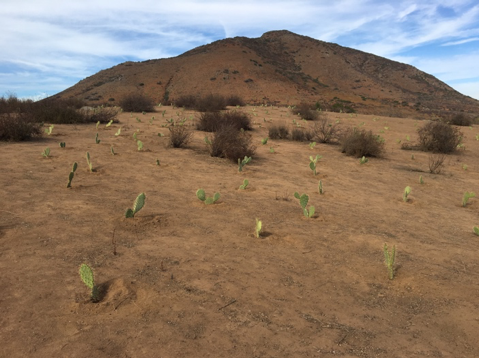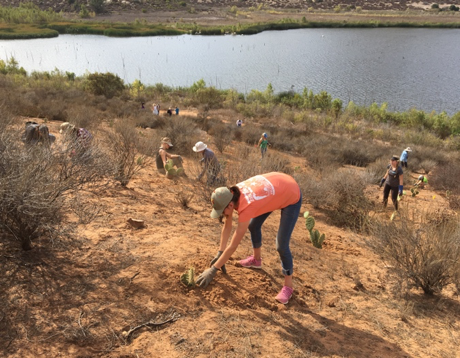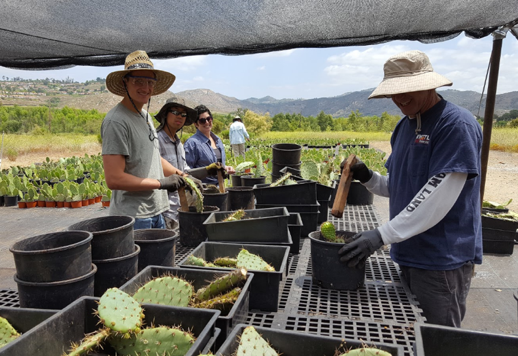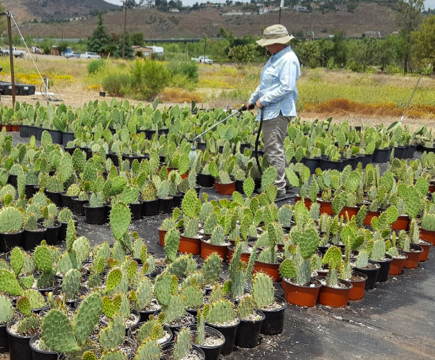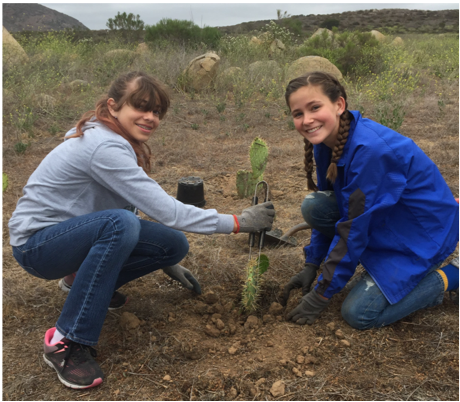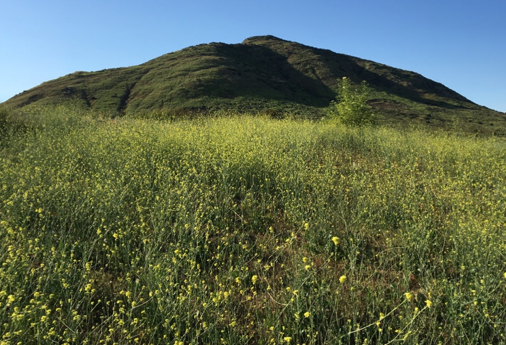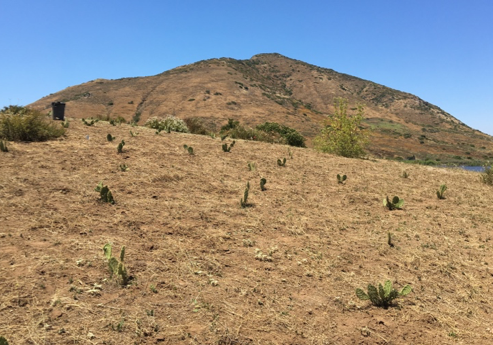North County Cactus Nursery and Coastal Cactus Wren Habitat Restoration (2015-2018)
The primary goal of this three-year project was to support the restoration and recovery of cactus wren (CACW) populations in the San Pasqual Valley/Lake Hodges region and other locations identified in coordination with the South San Diego County Coastal Cactus Wren Conservation Implementation Plan. The San Diego Zoo Institute for Conservation Research sought to aid the recovery of this species through 1) the creation of additional cactus wren habitat through large scale prickly pear propagation and 2) the removal of invasive plant species from new and existing cactus wren habitat. We established a cactus nursery that supplied 8056 locally sourced cacti to restoration projects throughout the region from 2015-2018. We also conducted extensive removal of invasive species at two major centers of cactus wren habitat: Lake Hodges and the San Diego Zoo Safari Park Biodiversity Reserve. This project provided wide ranging benefits to coastal cactus wren conservation not only by providing large-scale habitat restoration and management across the region, but also by documenting experiences and lessons learned during the development of the cactus nursery which can serve as a guide for the future establishment of other large scale cactus nurseries. We document herein the data collected from our propagation, restoration, invasive species removal efforts, and a propagation protocol which describes the methods we used for cactus propagation and nursery establishment.
Project Groups
-
SDMMP43 Cactus Wren Conservation Improvement Outcomes with Science Support
Project Focus
Cactus Wren, coastal pricklypear
Katherine Heineman
Joyce Maschinski
San Diego Zoo Institute for Conservation Research
Center for Natural Lands Management; City of San Diego, Public Utilities Department Watershed and Resource Protection Team; San Dieguito River Park
Joyce Maschinski
Kris Preston
Joyce Maschinski
Project Protocol
This protocol describes how to grow rooted cactus from cactus pads up to about 0.5 m in height. The document is the output of a submission to the Native Plant Network's Propagation Protocol Database operated by the US Forest Service. https://npn.rngr.net/propagation/protocols
Coastal cactus wren Campylorhynchus brunneicapillus sandiegensis
Goal: Protect, enhance, and restore suitable cactus scrub habitat for coastal cactus wrens to increase effective population size in each genetic cluster at a short term sustainable level (e.g. 50-100 wrens), rehabilitate habitat destroyed by wildfire, improve habitat quality to maintain populations during drought, enhance connectivity within and between genetic clusters to increase genetic diversity and rescue small populations, and manage anthropogenic predation risk to ensure the long term persistence (>100 years) of cactus wrens on Conserved Lands in the MSPA.
MGT-IMP-NUR CAMBRU-6
Management units: 2, 3, 4, 6
From 2017-2021, continue operation of the North San Diego County Cactus Nursery and support a South San Diego County Cactus Nursery to supply cactus to land managers to enhance, restore and create coastal cactus wren habitat. Grow cactus pads, segments and entire plants sufficient for restoration projects to expand and enhance cactus scrub habitat and as a source of plants for immediate habitat rehabilitation following severe wildfire.
| Action | Statement | Action status | Projects |
|---|---|---|---|
| IMP-1 | Implement BMPs when harvesting and growing cactus at a nursery in preparation for transplant into natural lands for cactus restoration projects and to provide an emergency source of cactus following wildfire. | some occurrences are in progress | North County Cactus Nursery and Coastal Cactus Wren Habitat Restoration (2015-2018) |
| IMP-2 | Grow and supply cactus pads, segments, and entire plants from locally harvested native cactus with a composition of species reflecting what naturally occurs in each geographic area. The North County Cactus Nursery should cactus to projects in MUs 6 and 8 and those areas in MU 4 dominated by prickly pear cactus. The South County Cactus Nursery should supply cactus to MUs 2 and 3 and to those areas in MU 4 dominated by coast cholla. The amount of cactus produced will be determined periodically based upon: management recommendations from the 2015 South San Diego County Coastal Cactus Wren Habitat Conservation and Management Plan; from ICR's Restoration Analyses for the San Pasqual Valley and Lake Hodges; an evaluation of planned and ongoing cactus restoration projects; and an assessment of cactus needed to be kept in reserve for future post-fire rehabilitation efforts. | some occurrences are in progress | North County Cactus Nursery and Coastal Cactus Wren Habitat Restoration (2015-2018) |
| IMP-3 | Submit project metadata, nursery plans, and reports with information on harvesting, growing and distributing cactus for restoration projects to the MSP Web Portal. | some occurrences are in progress | North County Cactus Nursery and Coastal Cactus Wren Habitat Restoration (2015-2018) |
| Criteria | Deadline year |
|---|---|
| Cactus Nurseries Established in North and South San Diego County to Provide Sufficient Cactus for Restoration and PostFire Rehabilitation | 2021 |
| Threat Name | Threat Code |
|---|---|
| Altered fire regime | ALTFIR |
| Climate change | CLICHN |
| Invasive plants | INVPLA |
| Loss of connectivity | LOSCON |
| Urban development | URBDEV |
